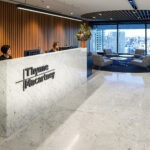The Queensland District Court recently awarded a passenger just under $120,000 in damages after she suffered serious injuries when she stepped backwards and fell down a set of stairs on a luxury catamaran.
Mrs Ellery – who was 82 years of age – was joining her family for a day cruise around the Whitsunday Islands in May 2012 and had entered the vessel’s main saloon area shortly after embarking the vessel. The precise circumstances of Mrs Ellery’s fall were not determined, but (seemingly unaware of her surrounds) she stepped backwards and fell down a short stairway leading from the saloon to the lower cabins. Mrs Ellery suffered multiple injuries in the fall, including fractured vertebrae and ribs, and needed to be airlifted to hospital where she stayed for over two months.
Despite concluding that Mrs Ellery had not proved that the stairway was a hidden danger and that she also ‘probably should have seen the stairway’, the Judge held the vessel operator breached its duty of care. The Judge concluded the operator had failed to address the risk of a fall down the stairway in its safety management system and that in the absence of a safety briefing prior to boarding the vessel the operator was negligent by failing to employ an ‘engineering solution’ (such as a physical safety barrier across the stairway) to prevent unwitting passengers from stepping backwards and falling down the stairway.
In arriving at this conclusion, the Judge noted that the design of the saloon stairway, featuring uniform wood panelling with some white embellishing, created a risk of injury to someone who – in the confined and unfamiliar surroundings of the saloon – might inadvertently step back into it. The Judge commented that while the stairway design no doubt produced an elegant and stylish vessel for private use, once the vessel was employed for commercial charter, the reasonable response to the risk required a different standard of fitting. The Judge accepted the evidence presented by an engineering expert (for Mrs Ellery) that the stairway should have been barricaded off until passengers were given a thorough safety briefing or were familiarised with the vessel.
Interestingly, the Judge sought to emphasise that his conclusion did not set a precedent for every business operating sailing charters and that in some cases operational procedures alone – such as literature, greetings, inductions or warnings – would discharge the operator’s duty to take reasonable care to avoid reasonably foreseeable risk of injury to passengers.
The Judge however also found that a reasonable person in Mrs Ellery’s position ought to have had some appreciation of their surroundings and taken some care to avoid the stairway, and accordingly the Judge considered Mrs Ellery should bear some responsibility and assessed the apportionment for contributory negligence at 30%.
The damages determined by the Judge totalled $168,536.70 (of which around $119,000 was for medical expenses incurred), and Mrs Ellery was therefore awarded damages of $117,975.69 after the 30% reduction for contributory negligence was applied. Mrs Ellery is however unlikely to receive much “in the hand” from the damages awarded after payment of her medical expenses.
Although the Judge specifically comments in his judgment that the decision should not to be taken as a precedent, the decision nonetheless would seem to place high standards on commercial vessel operators. It highlights the need for operators to be cautious and to ensure any fall hazards, access ways or possible hidden risks, particularly in confined or unfamiliar spaces, are properly addressed as part of the vessel’s safety management system and that appropriate precautions – for example, warnings, instructions or barriers – are implemented.
* Ellery v Sunsail (Australia) Pty Ltd [2014] QDC 285
Authors: Matthew Hockaday (Partner) and Lauren Hertel (Lawyer)





